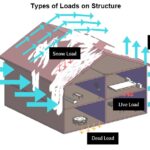The absolute volume method is used to calculate quantities of materials for concrete i.e. cement, sand, and aggregates for the production of 1m3 concrete of mix proportions such as 1:1.5: 3 (M20), 1:1:2 (M25).
This absolute volume method of calculating quantities of concrete materials is based on the principle that the volume of fully compacted concrete is equal to the absolute volume of all the materials of concrete, i.e. cement, sand, coarse aggregates, and water.
Calculate Quantities of Materials for Concrete
Given below is the formula for computing the materials mandatory for the volume of concrete:

Where, Vc = Absolute volume of fully compacted fresh concrete
W =Mass of water
C = Mass of cement
Fa = Mass of fine aggregates
Ca = Mass of coarse aggregates
Sc, Sfa, and Sca refer to the definite gravities of cement, fine aggregates, and coarse aggregates correspondingly.
The air content is not included in this estimation.
This estimation process toward quantities of materials for concrete involves the mix proportions from the design mix or nominal mixes for structural stability and longevity requirement.

Calculating Quantities of Materials for M25 Concrete
Consider concrete with a mix proportion of M25 concrete 1:1:2 where, 1 is part of cement, 1 is part of fine aggregates and 2 is part of coarse aggregates of the maximum size of 20mm. The water-cement ratio required for mixing concrete is taken as 0.45.
Consiider bulk densities of materials per cubic meter, cubic feet and cubic yards as follows:
Cement = 1500 kg/m3 = 93.642 lb/ft3 = 2528.332 lb/cubic yards
Sand = 1700 kg/m3 = 105 lb/ft3 = 2865.443 lb/cubic yards
Coarse aggregates = 1650 kg/m3 = 103 lb/ft3 = 2781.166 lb/cubic yards
Specific gravities of concrete materials are as follows:
Cement = 3.15
Sand = 2.6
Coarse aggregates = 2.6.
The percentage of entrained air assumed is 2%.
The mix proportion of 1:1.5:3 by dry volume of materials can be expressed in terms of masses as:
Cement = 1 x 1500 = 1500
Sand = 1 x 1700 = 1700
Coarse aggregate = 2 x 1650 = 3300.
Therefore, the ratio of masses of these materials w.r.t. cement will as follows
= 1 : (1700/1500) : (3300/1500)
= 1 : 1.1 : 2.2
The water cement ratio = 0.45
Now we will calculate the volume of concrete that can be produced with one bag of cement (i.e. 50 kg cement) for the 1: 1.1: 2.2 proportions of M25 concrete materials.
Thus, the absolute volume of concrete for 50 kg of cement:
=> Vc = {(0.45×50)/1000}+{(1×50)/(1000×3.15)}+{(1.1×50)/(1000×2.6)}+{(2.2×50)/(1000×2.6)}
=> Vc = 0.0225 + 0.0159 + 0.0211 + 0.0423 = 0.1018 m3
Thus, for the proportion of mix 1:1:2 (M25), with one bag of cement of 50 kg, 0.1018 m3 of concrete can be produced.
Considering an entrained air of 2%. Thus the actual volume of concrete for 1 cubic meter of compacted concrete construction will be = 1 -0.02 = 0.98 m3.
Thus, the quantity of cement required for 1 cubic meter of concrete = 0.98/0.1018 = 9.63 bags of cement.
The quantities of materials for 1 m3 of M25 concrete can be calculated as follows:
The weight of cement required = 9.63 x 50 = 481.5 kg.
Weight of fine aggregate (sand) = 1 x 481.5 = 481.5 kg.
Weight of coarse aggregate = 2 x 481.5 = 963 kg.
Calculating Quantities of Materials Concrete for M20
Consider concrete with a mix proportion of M20 (1:1.5:3 mix ratio). The water-cement ratio required for mixing concrete is taken as 0.45.
Bulk densities and specific gravities of the materials are taken as given above.
The mix proportion of 1:1.5:3 by dry volume of materials can be expressed in terms of masses as:
Cement = 1 x 1500 = 1500
Sand = 1.5 x 1700 = 2550
Coarse aggregate = 3 x 1650 = 4950.
Therefore, the ratio of masses of materials w.r.t. cement will as
= 1: (2550/1500): (4950/1500) = 1 : 1.7 : 3.3
The water cement ratio = 0.45
Now calculate the volume of concrete that can be produced with one bag of cement (i.e. 50 kg cement) for the mass proportions of concrete materials.
Thus, the absolute volume of concrete for 50 kg of cement:
= Vc = (0.45×50)/1000 + (1×50)/(1000×3.15) + (1.7×50)/(1000×2.6) + (3.3×50)/(1000×2.6)
=> Vc = 0.1345 m3
Thus, for the proportion of mix 1:1.5:3 (M20) considered, with one bag of cement of 50 kg, 0.1345 m3 of concrete can be produced.
We have considered an entrained air of 2%. Thus the volume of 1 cubic meter of compacted concrete construction will be = 1 -0.02 = 0.98 m3.
Thus, the quantity of cement for 1 m3 of concrete = 0.98/0.1345 = 7.29 bags.
The quantities of materials for 1 m3 of M20 concrete is calculated as follows:
The weight of cement = 7.29 x 50 = 364.5 kg.
Weight of fine aggregate (sand) = 1.5 x 364.5 = 546.75 kg.
Weight of coarse aggregate = 3 x 364.5 = 1093.5 kg.




